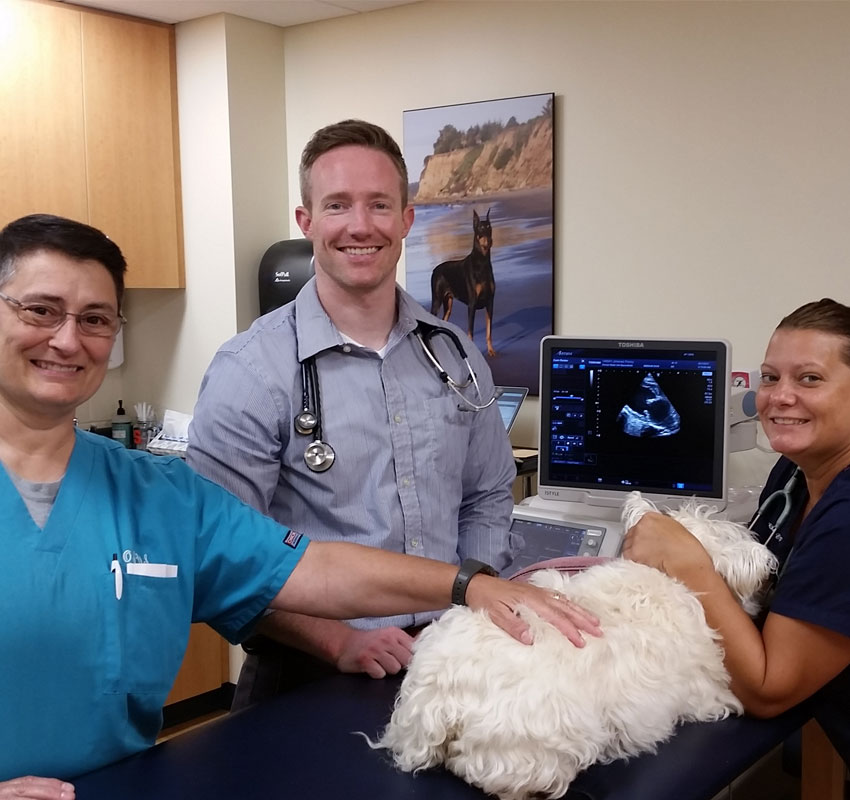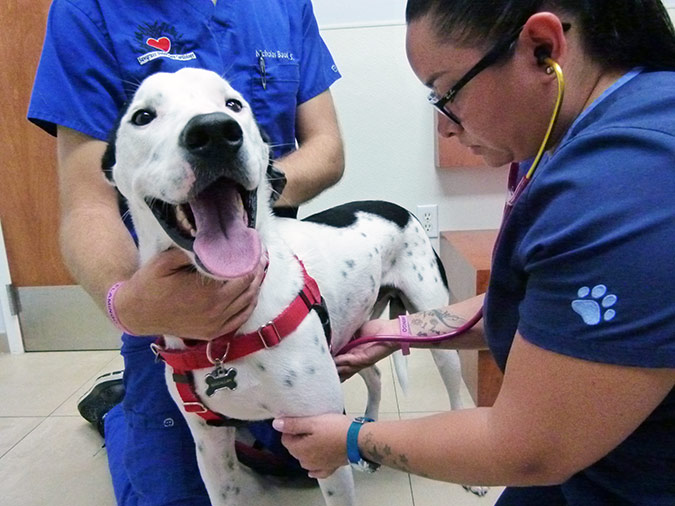The Role of Ultrasound and CT Scan in Modern Veterinary Practices: Insights From Experienced Professionals
In contemporary vet methods, ultrasound and CT scans substantially improve analysis abilities. These imaging methods provide vital insights into animal wellness, guiding therapy decisions. Experienced professionals identify the distinct benefits of each modality. Ultrasound offers real-time analyses, while CT checks provide elaborate physiological information. Understanding their applications and duties increases vital concerns concerning their effect on person end results and the future of veterinary diagnostics. What understandings can be acquired from their combined usage?
Comprehending Ultrasound in Vet Medication
Ultrasound is a crucial diagnostic tool in veterinary medication, providing a non-invasive method to visualize inner structures. This imaging technique uses high-frequency acoustic waves to develop real-time pictures of organs and cells, allowing veterinarians to analyze problems without surgical intervention. Common applications include evaluating the heart, liver, kidneys, and reproductive organs, along with checking pregnancies.The procedure is fairly fast and can be carried out in various setups, making it an available alternative for veterinarians. Unlike radiography, ultrasound provides thorough info concerning soft cells and blood flow, which is vital for accurate diagnoses.Veterinary specialists count on ultrasound to identify problems such as growths, cysts, and liquid build-up. Its capability to guide biopsies and other procedures further improves its utility in professional method. By using a reliable and safe method to examine internal anatomy, ultrasound has actually become a keystone of contemporary vet diagnostics.
The Advantages of CT Scans for Animal Diagnostics
CT checks deal significant advantages in vet diagnostics by supplying improved precision in identifying internal conditions (CT Scans For Animals). As a non-invasive imaging strategy, they ensure the security and comfort of pets throughout evaluations. On top of that, CT checks facilitate a detailed assessment of internal frameworks, enabling more efficient therapy preparation
Enhanced Diagnostic Precision
Advancements in imaging innovation have substantially enhanced diagnostic accuracy in vet medicine, particularly via the usage of CT scans. These scans supply thorough cross-sectional photos of an animal's interior structures, permitting veterinarians to determine problems with accuracy. The high resolution and three-dimensional capacities of CT imaging assist in the discovery of problems such as tumors, cracks, and interior blood loss that may be missed out on with typical imaging methods. In addition, CT scans can assist in pre-surgical planning by offering a comprehensive view of physiological connections. This level of detail not only enhances the precision of medical diagnoses however also help in customizing effective treatment plans. As a result, the assimilation of CT modern technology right into vet practices is changing the landscape of animal medical care, boosting results for people.
Non-Invasive Imaging Technique
The introduction of non-invasive imaging strategies has transformed animal diagnostics, with CT scans becoming a famous tool in vet methods. These scans supply high-resolution, cross-sectional pictures of a pet's inner structures, allowing vets to evaluate complex problems without the demand for invasive procedures. The benefits of CT scans include their ability to detect growths, cracks, and interior blood loss with amazing precision. In addition, they facilitate the assessment of soft cells and body organs, improving analysis capabilities. The speed of CT scanning makes it possible for quick decision-making, which is important in emergency scenarios. By reducing stress and pain for the animal, CT scans add to a much more gentle method to diagnostics, ultimately boosting treatment end results and progressing veterinary treatment.
Comprehensive Internal Evaluation
A comprehensive internal evaluation is vital for accurate diagnosis and reliable therapy in veterinary medicine. CT checks offer significant advantages in this regard, supplying detailed cross-sectional photos of an animal's inner structures. This sophisticated imaging method enhances visualization of intricate physiological regions, making it possible for veterinarians to recognize irregularities such as lumps, fractures, and interior blood loss with greater accuracy. Additionally, CT checks assist in the analysis of conditions that may be challenging to identify via traditional techniques. The speed and precision of CT imaging also add to timely interventions, boosting individual outcomes. As vet practices progressively include CT technology, the benefits of comprehensive internal evaluations end up being obvious, strengthening the value of this tool in modern veterinary diagnostics.
Contrasting Ultrasound and CT Imaging Techniques
While both ultrasound and CT imaging serve necessary duties in vet diagnostics, each technique offers distinctive benefits and limitations that can influence scientific decision-making. Ultrasound is especially valued for its real-time imaging capacities, enabling veterinarians to observe dynamic physiological processes. This method is non-invasive, portable, and does not include ionizing radiation, making it a safer click reference choice for both pets and medical professionals. Ultrasound might have constraints in picturing particular anatomical structures or deep tissues.Conversely, CT imaging offers comprehensive cross-sectional sights of the body, allowing for precise localization of abnormalities. It stands out in reviewing complex body organs and structures, specifically in the thorax and abdominal area. CT scans call for sedation or anesthetic in several instances and involve direct exposure to ionizing radiation. Eventually, the choice in between ultrasound and CT relies on the particular clinical situation, the area of rate of interest, and the necessity of the diagnostic needs.
Situation Researches: Successful Diagnoses Via Imaging
Instance studies highlight the significant enhancements in diagnostic accuracy attained through sophisticated imaging modern technologies like ultrasound and CT scans in vet techniques. These innovations not just boost the detection of different conditions yet additionally assist in reliable and prompt therapy strategies. Evaluating details instances can highlight the transformative impact of these imaging methods on vet medicine.
Diagnostic Precision Improvements

Imaging Modern Technology Advancements
As veterinary imaging technology remains to advance, its effect on diagnostic capabilities ends up being significantly noticeable. Recent case research studies highlight the effective application of advanced ultrasound and CT check techniques in identifying complex conditions. For example, a veterinary clinic made use of high-resolution CT scans to detect an unusual kind of lung cancer cells in a pet dog, which traditional imaging had missed. An ultrasound examination disclosed an abdominal mass in a cat, prompting timely surgical intervention and a positive outcome. These developments not only improve diagnostic precision yet additionally make it possible for vets to develop targeted treatment plans. By leveraging cutting-edge imaging technologies, vet specialists are markedly improving person care, leading to more reliable administration of numerous wellness problems in pets.
The Function of Imaging in Emergency Veterinary Treatment
Imaging plays a vital role in emergency situation vet treatment, offering veterinarians with crucial info needed to make fast, informed choices. In urgent situations, techniques like ultrasound and CT scans allow specialists to quickly analyze a family pet's inner structures, recognizing critical problems such as internal bleeding, fractures, or organ problems. These imaging techniques enable real-time evaluations, promoting prompt treatments that can be life-saving. For example, ultrasound is very useful for reviewing soft tissue injuries and problems like liquid buildup, while CT scans offer thorough pictures of complicated physiological frameworks, crucial for identifying injury instances. The rate and accuracy of these imaging methods boost the vet's capacity to devise effective therapy strategies, making certain the very best feasible results for their individuals. The combination of advanced imaging innovations into emergency vet techniques is not only advantageous but significantly essential, as it boosts analysis capacities and improves overall animal care throughout essential minutes.

Training and Competence in Veterinary Imaging
Although sophisticated imaging techniques such as ultrasound and CT scans are important for reliable veterinary treatment, the successful execution of these innovations greatly depends on the training and competence of vet specialists. Skillful use of imaging tools requires detailed understanding of composition, pathology, and the concepts underlying each modality. Vet experts have to undertake continue reading this customized training to precisely analyze imaging outcomes, which is crucial for detecting conditions and intending treatment.Certifications and proceeding education in veterinary imaging improve the abilities of specialists, allowing them to remain upgraded with technological developments. Collaboration in between radiologists and veterinarians commonly leads to enhanced diagnostic accuracy, as experts can offer insights into complex cases. On top of that, sensible experience in handling imaging devices fosters confidence in its application. Ultimately, the quality of veterinary imaging services is straight associated to the level of training and proficiency possessed by the experts using these vital diagnostic tools.
Future Trends in Diagnostic Imaging for Animals
With the rapid advancements in innovation, vet diagnostic imaging is positioned for substantial advancement in the coming years. Arising fads suggest a shift towards more accessible and portable imaging techniques, such as handheld ultrasound devices, which could enhance area diagnostics. Furthermore, the integration of man-made knowledge is expected to change picture evaluation, permitting quicker and a lot more accurate analyses of results.Moreover, improvements in 3D imaging methods and computed tomography will certainly offer veterinarians with more detailed views of pet composition, causing improved treatment strategies. Online reality technology might likewise play a role in medical preparation and education, giving vets a distinct viewpoint on intricate cases.As telemedicine remains to grow, remote assessments promoted by diagnostic imaging will certainly become a lot more common, enabling professionals to aid general practitioners in real-time. Generally, these patterns are readied to boost the effectiveness and efficiency of vet care, eventually boosting pet outcomes.
Often Asked Inquiries
Exactly How Much Do Ultrasound and CT Scans Expense in Vet Clinics?
The costs of ultrasound and CT scans in vet clinics normally range from $300 to $1,500, relying on variables such as location, center kind, and details treatments required for the animal's diagnosis and treatment.

Exist Any Type Of Threats Related To Ultrasound and CT Checks for Pets?
Ultrasound and CT scans typically posture minimal risks to pet dogs. Potential concerns consist of sedation reactions and direct exposure to anesthetics. Veterinarians meticulously evaluate each case to mitigate any kind of dangers related to these diagnostic treatments
For How Long Do Ultrasound and CT Treatments Commonly Take?
Ultrasound treatments generally take about thirty minutes to an hour, depending on the complexity. CT scans, being more comprehensive, generally call for half an hour to 90 mins, including preparation and recovery time for the family pet.
Can All Veterinarians Perform Ultrasounds and CT Scans?
Not all vets can carry out ultrasounds and CT scans. Specialized training and qualification are often needed to assure competency in these sophisticated imaging techniques, which might restrict their availability to veterinarians with extra qualifications and resources.
What Kinds Of Pets Benefit A Lot Of From These Imaging Techniques?
Particular animal species, specifically felines and pets, benefit substantially from ultrasound and CT scans. These imaging techniques enhance diagnostic precision for problems like growths, internal injuries, and organ irregularities, resulting in enhanced therapy results and patient treatment. The high resolution and three-dimensional capacities of CT imaging assist in the discovery of problems such as tumors, fractures, and internal bleeding that might be missed out on with conventional imaging methods. Case studies highlight the substantial renovations in analysis precision attained through sophisticated imaging modern technologies like ultrasound and CT scans in vet practices. Improving analysis accuracy in vet practices has been considerably aided by developments in imaging modern technologies such as ultrasound and CT scans. Advanced imaging strategies such as ultrasound and CT scans are crucial for efficient vet treatment, the successful execution of these innovations greatly depends on the training and competence of vet professionals. Vet professionals should undergo specialized training to precisely analyze imaging outcomes, Board Certified Veterinary Cardiologist which is essential for diagnosing conditions and preparing treatment.Certifications and continuing education and learning in veterinary imaging enhance the abilities of practitioners, allowing them to stay updated with technical improvements.